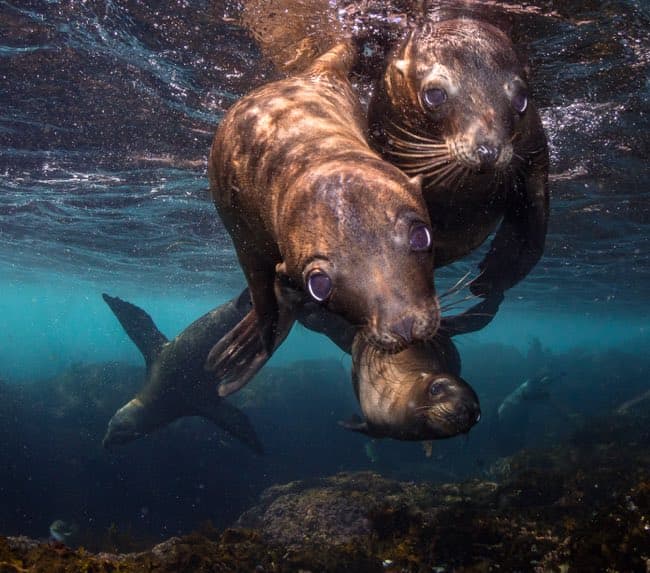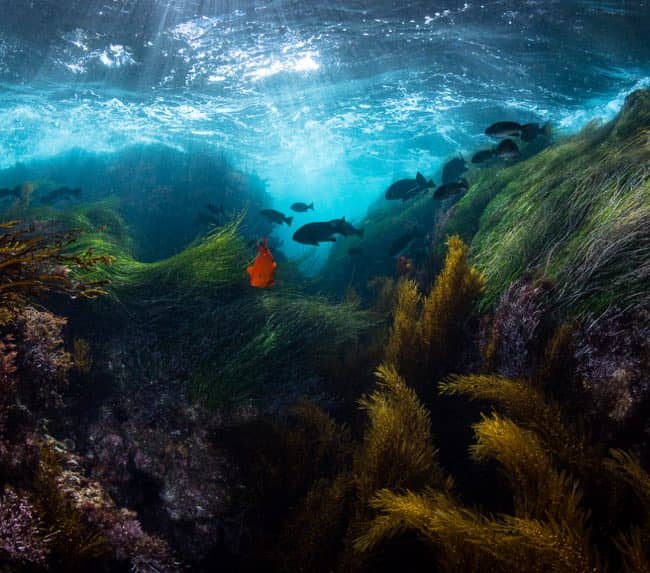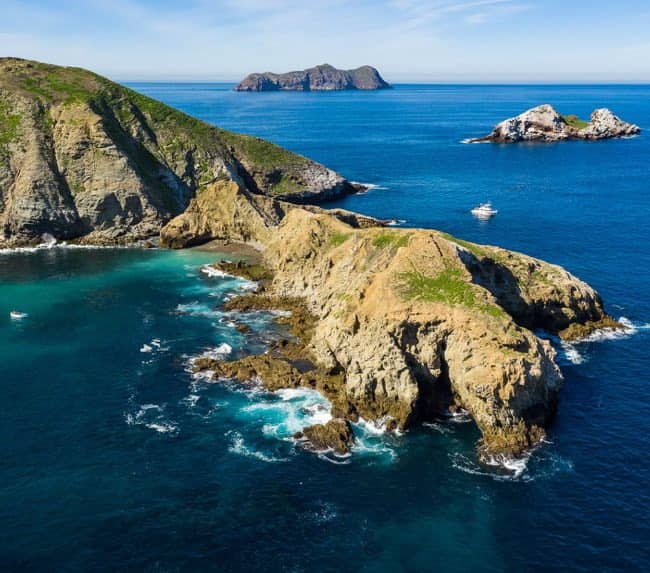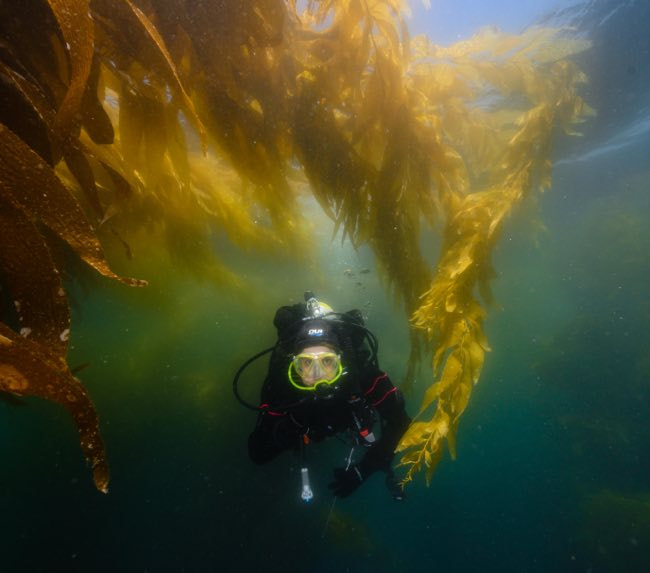Coronado Islands Diving
Must-see sites
Lobster Shack
Keyhole
Middle Grounds
all in Mexican waters 🇲🇽
Water Temp
52° to 60°F / 11° to 15°C
Visibility
30 to 100 ft / 9 to 30 m
Gear
Diving: 7mm wetsuit or drysuit, hood, booties, gloves
Snorkeling: 5mm or 7mm wetsuit
When to Go
Diveable: Year-round
Best: late fall & winter (sea lion diving season)
Access
Boat only (private or commercial)
Boats and guests require Mexican permits
Marine Life
California Sea Lion
California Two-spot Octopus
California Moray
Finescale Triggerfish
Garibaldi
California Scorpionfish
California Sea Hare
Harbor Seal
Full-day trip to sea lion rookery
All permits included in price, require passport
What is Coronado Islands diving like?
Only 8 miles off the coast of Baja California, Mexico, lies a rocky island chain well-known for its epic sea lion encounters and clear blue waters rarely seen in Southern California.
Coronado Islands diving packs most of what San Diego scuba diving and snorkeling offers, plus more:
- Sea lion sightings - encounters are 99.9% guaranteed
- Clearwater - visibility here is up to 40 ft better than coastal San Diego
- Warm(er) water - usually a few degrees higher than coastal San Diego
- Shallow sites - welcoming and entertaining to all levels
The Coronado Islands are just over an hour's boat ride from San Diego, in Mexican waters. To get there, you won't cross any border checkpoints, but to visit the islands you need to have a valid passport.
Apart from a small military detachment, the islands remain largely uninhabited, allowing space for all sorts of creatures both on land and below the waves.
Video by Peter Neubauer
✨ SEA LION DIVING TIP: We have the only commercial boat in San Diego licensed for Coronado Islands diving and snorkeling. Trips fill up fast, especially during the fall (sea lion season). We recommend making your plans and booking your spot with a month or two in advance.
Where can you dive in Coronado Islands?
The North Island is home to a small colony of sea lions and divers will sometimes want to spend their whole trip enjoying a dive with these playful pinnipeds.
Offshore diving conditions here tend to keep waters above 65°F and lead to rare boat sightings with creatures such as gray whales, mola mola, blue sharks, and skipjack tuna.
Don’t let the boat ride deter you, having a sea lion pup tickle his whiskers on your glove or a mola mola casually swim past the boat will make it worth the trip!
✨ MEXICO TRAVEL TIP: Coronado Islands diving require that you have a valid passport or passport card, regardless of its issuing country. Immigrants must hold their valid visas or residency permits, as if traveling by plane.
What marine life calls Coronado Islands home?
Many of the usual Southern California sea creatures can be found here, with a few major exceptions such as finescale triggerfish, elephant seals, and some pelagic fish species like skipjack tuna, mola mola, and yellowtail.
The main attraction here is diving with sea lions. Shortly after pupping season (spring and summer months), the friendly pups will blow bubbles in your face or even zoom by with their mouth open.
If you find yourself tired of the sea lion activity, try looking for some of the hidden reef creatures like two-spot octopus, moray eels, and scorpionfish, all of which can be found along the shallow reefs of Coronado Islands.

Photo by Frankie Grant

Photo by Frankie Grant
Weekly trips in two dive boats
Closest commercial dock to the ocean
Lobster Shack

Photo by Frankie Grant
Depth: 15 - 60 ft (5 - 18 m)
Level: Open Water
The premier sea lion dive site in Southern California, Lobster Shack is straightforward and a great site for beginners.
The rocky cliffs circle around a small cove, creating what looks like an amphitheater around the sea lion colony. At shallower depths the flats are filled with several types of sargassum, split up by a few pockets for divers to sit and wait for a curious sea lion pup.
For the rocky shoreline, there are several stair-step ledges that gradually drop down to 60 ft where the rocks finally give way to sand.
✨ SEA LION PHOTOGRAPHY TIP: Patience is key! If sea lions are active, try to find a nice spot along the wall to settle and compose your shot. If you're in the right place, the sea lion will come right into the frame you had already composed.
Keyhole

Photo by Nathan Pierce
Depth: 15 - 80 ft (5 - 24 m)
Level: Open Water
Located at the south tip of the North Island, this dive site receives a consistent flow of clear water and normally has better visibility than other Coronado Islands diving grounds.
Just before the end of the Island, a channel running through the island is connected by a small archway about 15 ft wide above the waterline, making the channel look like a keyhole on a door.
As you would expect, this channel has a bit more surge than the surrounding area, it opens up large enough for a dump truck to drive through it underwater at a depth of 8 - 10 ft.
The shallow ledges located to the North of the channel are covered in surf grass, which glows a beautiful green in the midday sun. This shallow, grassy area provides many photographic opportunities for divers who remembered their wide angle lenses.
Middle Grounds

Photo by Phil Cola
Depth: 15 - 60 ft (5 - 18 m)
Level: Open Water
Middle Grounds is the name for the area located between the North and South Islands. Its calm and shallow cove has become one of our favorite Coronado Islands diving sites.
A finger reef approximately 150 ft wide extends to the north from the island, protected by an even larger finger to the west and an eelgrass bed to the east.
Along the top of the finger depths are barely 20 ft while the sides quickly drop down to 60 ft and meet the sandy rubble bottom.
✨ BOAT DIVING TIP: The trip to the Coronado Islands from San Diego is over an hour and, once there, you’re on the water all day. If unsure if you’ll get seasick, take some medication the night before. Better safe than sorry!
Other Coronado Islands diving sites
Other notable Coronado Islands diving sites include Toilet Bowl Grotto, Moonlight Cove, and Pukey Point.
We usually steer clear of these sites as they can be extra surgey and not suited for beginner divers. Venturing to the South Island is also not advised as to not interfere with Mexican Naval Installation and Tuna Pens activity.
Tanks and weights included
Friendly crew and creature comforts




